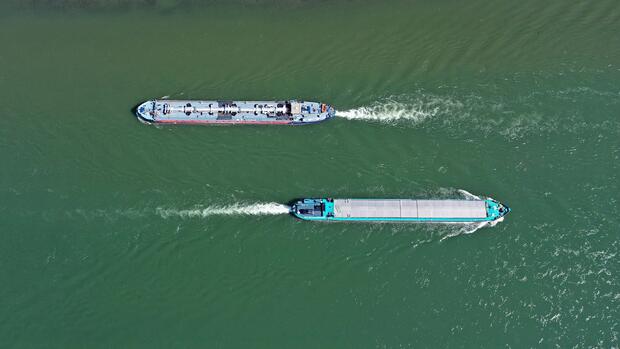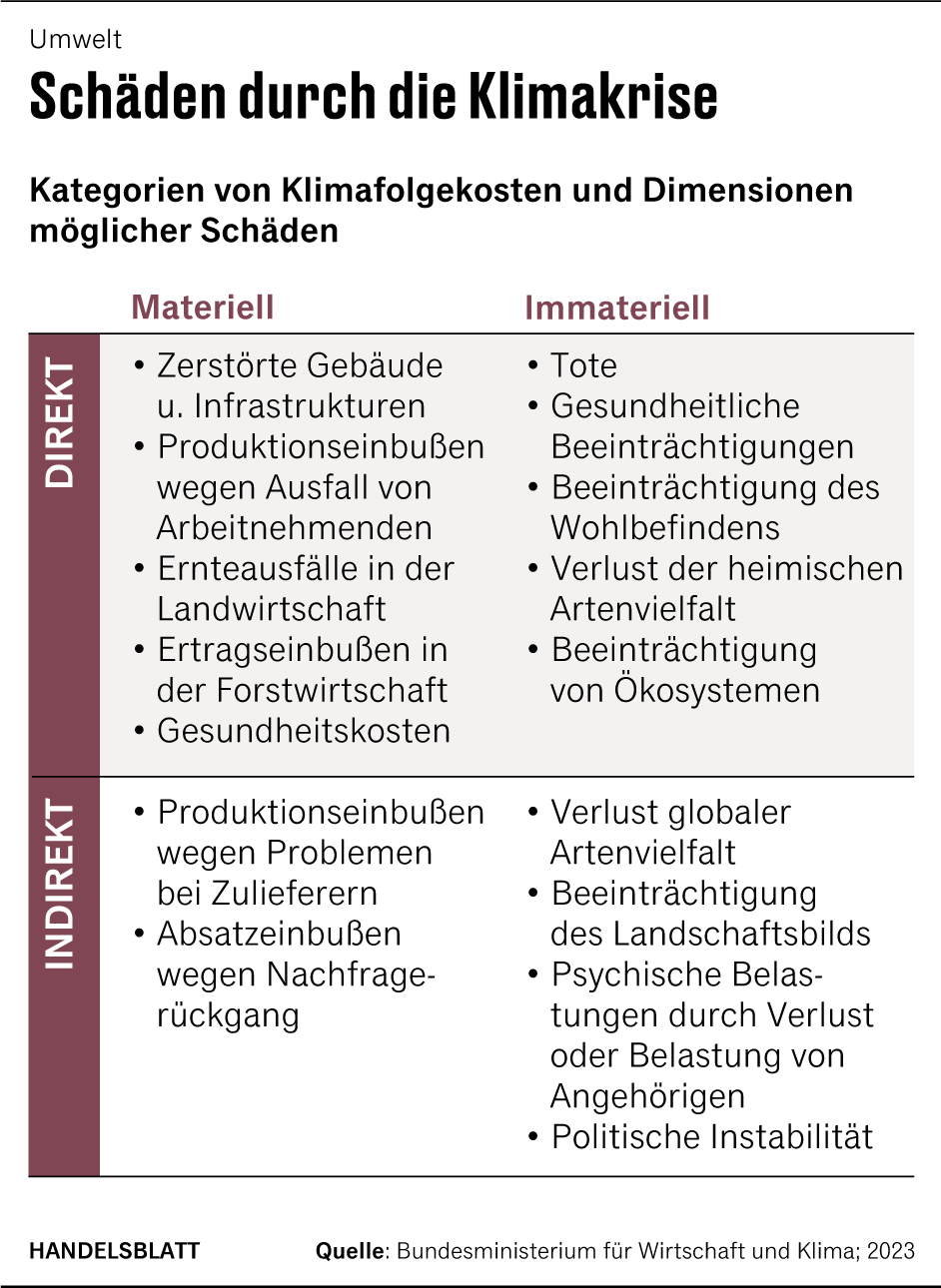Berlin The drought in Germany is becoming a burden for inland shipping. The reason: the water levels of many rivers are so low that ships can only navigate them more slowly and with less cargo. This leads to higher transport costs.
The water level in Kaub is used as a yardstick for assessing the situation on the Rhine, Germany’s most important waterway. The place near Koblenz near the Loreley rock in the Unesco World Heritage Upper Middle Rhine Valley is an important bottleneck for all Rhine shipping. The water level there recently dropped to 103 centimeters, according to data from the DTG shipping cooperative. Water levels below 135 centimeters here mean that large container ships have to noticeably reduce their cargo – in some cases by half.
North Rhine-Westphalia’s Environment Minister Oliver Krischer (Greens) told the Handelsblatt: “The Rhine is the lifeline of the German economy.” Its navigability means maintaining prosperity and climate protection at the same time. “Without water, no ship, without ship, no economy, without economy, no turnaround in traffic.” Here is an overview of the location:
How important is the Rhine for the economy?
According to the Bundesverband der Deutschen Binnenschifffahrt (BDB), the Rhine is by far the most important and busiest inland waterway in Europe. Around 80 percent of goods traffic in inland waterways takes place on this international highway, which connects the western seaports with the hinterland.
For German companies, the Rhine plays an important role in supplying coal, oil, chemicals, stones, metals and agricultural goods. The goods are at the beginning of many production chains, so that failures in their transport can lead to production impediments in downstream production stages.
>> Read also: Which companies and funds benefit from dryness and drought
According to data from the Federal Statistical Office, a total of 182 million tons of goods were transported on German inland waterways in 2022. That was the lowest transport volume since reunification in 1990.
“One of the reasons for this low is likely to be a decline in the production of important goods to be transported and the low water in August 2022,” it says. Since 2018, the Rhine has regularly recorded low water levels.
What are the reasons for the low water?
According to the Federal Institute for Hydrology (BfG), low water is a phenomenon that recurs almost every year in Central Europe, albeit to varying degrees. It is basically due to the weather or the season, depending, among other things, on precipitation in spring and summer and snowfall in winter. These in turn are influenced by the climate crisis. The BfG currently sees the water levels of the federal waterways “below the seasonal average values of the past few years”.
Environmental politician Krischer is convinced that the climate crisis will cause droughts more and more frequently in the coming years. He therefore calls for a “development perspective up to 2030”. Three points are essential for him: a fleet of ships adapted to low water, a plan to counteract the lack of water on the Rhine and better unloading facilities.
Are negative effects on the economy to be expected because of the low water?
At low water, the federal waterways narrow the navigation channel, said the BfG. As a result, the sailing speed and loading capacities of the ships decrease. “This means that more shipping space has to be made available in existing or additionally chartered ships for the same amount of cargo.”
Especially during longer periods of low water, there is a shortage of available free shipping capacity, which leads to a disproportionate increase in transport costs.
Marc Schattenberg, analyst at Deutsche Bank Research, considers the development of the water levels on the Rhine to be “worrying”, as the levels are well below the ten-year average. “Should the levels approach or reach the lows of 2018 or 2022, this could certainly affect the recovery of the German economy,” Schattenberg told the Handelsblatt.
>> Read also: Drought in Europe: When will our water become scarce?
Stefan Kooths, head of economic activity at the Kiel institute IfW, explained that so far “no serious effect has been seen as with the low water period in 2018”, even if there are initial restrictions on shipping. At the moment, the water levels at the Kaub measuring point are “still a good deal above the mark of 78 centimeters that we have identified as critical”.
In addition, chemical production in particular, but also other energy-intensive areas that use waterways, have already significantly reduced their production as a result of the energy crisis, “so that there is less added value in the fire”.
The water level in Kaub is used as a yardstick for assessing the situation on the Rhine, Germany’s most important waterway.
(Photo: dpa)
In addition, adaptation measures have already been taken against the background of the experiences from 2018. For example, special ships would be used that could also sail at lower water levels. “All in all, the production-hindering effect should not be very significant for the economy as a whole,” emphasized Kooths.
The chemical industry in particular is dependent on inland waterway vessels. How does she arm herself?
Since the extreme low water in the Rhine in 2018, the industry has been preparing for more dry years. “The companies have the situation under control,” said Ulrike Zimmer, Head of Technology and Environment at the Association of the Chemical Industry (VCI), the Handelsblatt. She cites optimized transport concepts as an example. “The authorities’ water level forecasts have also become more reliable, so that companies can prepare for low water levels more quickly,” explained Zimmer.
“Nevertheless, not everything is on course,” added the expert, referring to the “Low Water Rhine” action plan that the federal government presented four years ago. “The bottlenecks on the Middle and Lower Rhine must be eliminated as quickly as possible – and not only in 2037.” This was originally supposed to be implemented in 2033.
What does BASF do?
At its largest plant at its headquarters in Ludwigshafen, the chemical group BASF handles around 40 percent of the incoming and outgoing transport volume across the river – this corresponds to the load of 15 barges every day. “The Rhine is an important traffic artery for us,” said a spokeswoman for the Handelsblatt.
According to the company, after 2018 BASF, together with the Federal Institute for Hydrology, implemented a digital early warning system for low water with a warning time of up to six weeks. In addition, the number of ships suitable for low tide that operate exclusively on charter for BASF has been doubled. The flagship is the “Stolt Ludwigshafen”, which has been in operation since the end of April. In the past, a low water level led to a temporary production stop in Ludwigshafen, which resulted in high costs for BASF.
Unfortunately, the implementation of the “enormously important project for unloading optimization in the Middle Rhine” has been delayed. The project aims to eliminate local bottlenecks deep in the Rhine. The project is part of the Federal Transport Routes Plan, but according to BASF, progress is slow. “We appeal to the federal government to implement this project, which is extremely important for all industrial sectors dependent on the Rhine, as quickly as possible,” said the spokeswoman.
More: What does the extreme weather mean for Mediterranean holidays?


